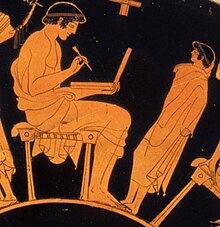
Back Mum lövhələr Azerbaijani Цэра Byelorussian Tauleta de cera Catalan Vosková tabulka Czech Wòskòwô tôblëczka CSB Wachstafel German Κηρωμένη πινακίδα Greek Vaksa tabulo Esperanto Tablilla de cera Spanish Vahatahvel Estonian

A wax tablet is a tablet made of wood and covered with a layer of wax, often linked loosely to a cover tablet, as a "double-leaved" diptych. It was used as a reusable and portable writing surface in antiquity and throughout the Middle Ages. Cicero's letters make passing reference to the use of cerae, and some examples of wax-tablets have been preserved in waterlogged deposits in the Roman fort at Vindolanda on Hadrian's Wall. Medieval wax tablet books are on display in several European museums.
Writing on the wax surface was performed with a pointed instrument, a stylus. A straight-edged spatula-like implement (often placed on the opposite end of the stylus tip) would be used as an eraser. The modern expression of "a clean slate" equates to the Latin expression "tabula rasa".

Wax tablets were used for a variety of purposes, from taking down students' or secretaries' notes to recording business accounts. Early forms of shorthand were used too.
© MMXXIII Rich X Search. We shall prevail. All rights reserved. Rich X Search